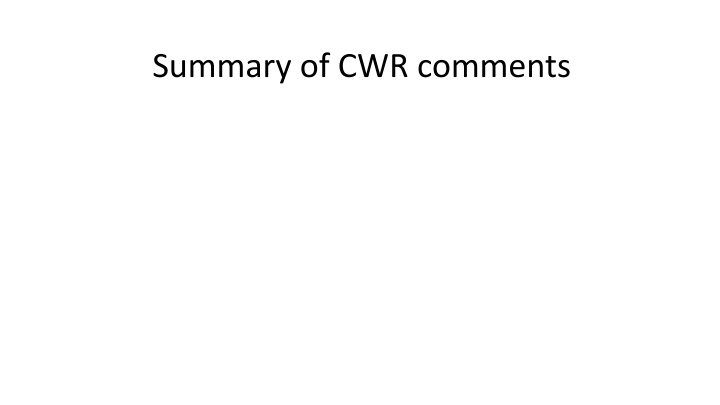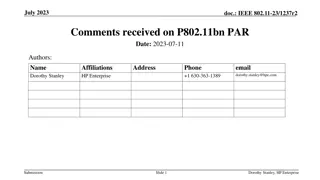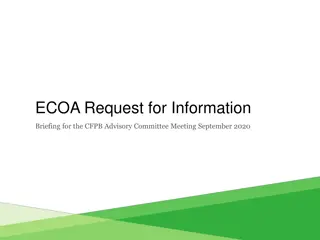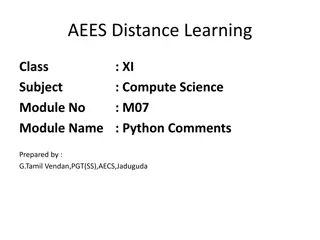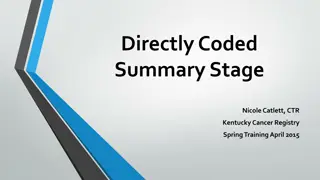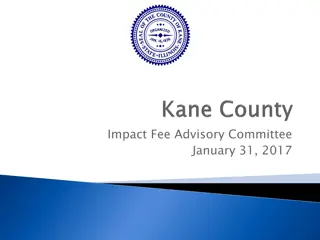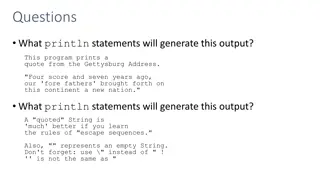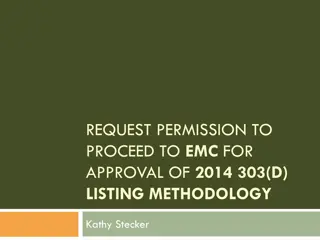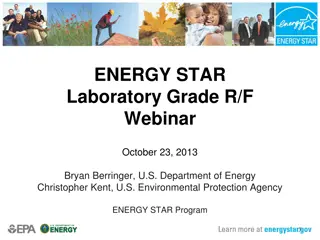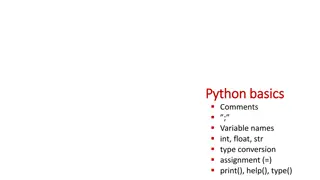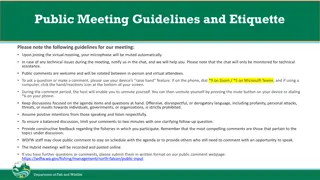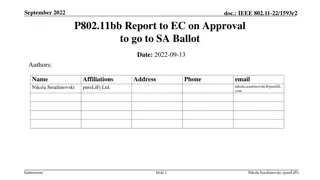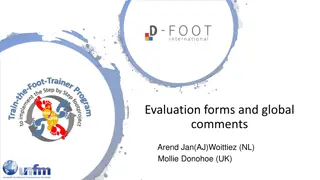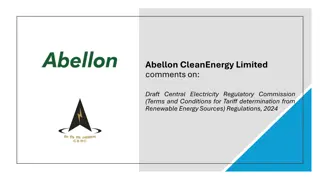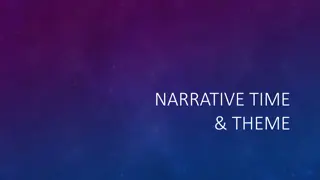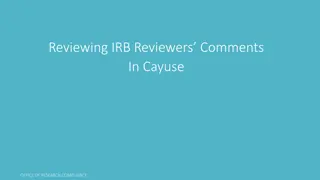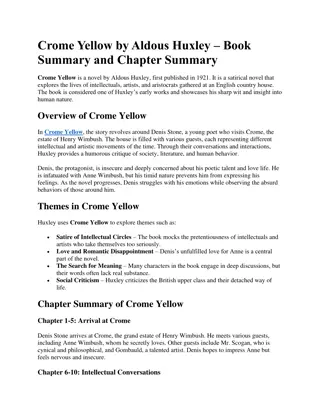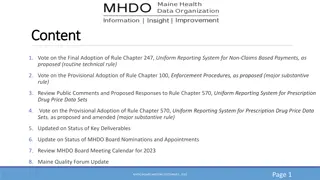Summary of CWR comments
In this summary, discussions revolve around the exploration of SUSY parameters, validation regions, and background contributions in a diphoton analysis. Key points include adjusting parameters to produce specific neutralino branching ratios and the effectiveness of shape analysis in rejecting fake photons.
Download Presentation

Please find below an Image/Link to download the presentation.
The content on the website is provided AS IS for your information and personal use only. It may not be sold, licensed, or shared on other websites without obtaining consent from the author.If you encounter any issues during the download, it is possible that the publisher has removed the file from their server.
You are allowed to download the files provided on this website for personal or commercial use, subject to the condition that they are used lawfully. All files are the property of their respective owners.
The content on the website is provided AS IS for your information and personal use only. It may not be sold, licensed, or shared on other websites without obtaining consent from the author.
E N D
Presentation Transcript
Analysis >-Line 42 and following: how general are the models of gauge-mediated supersymmetry breaking addressed >in this search: I have the impression that given the requirement of the analysis selection, the regions of >SUSY parameters and of the phase space explored remain relatively small. For example, in lines 125 and >126, why the M1 and mu parameters are adjusted to produce the neutralino BR to 50%, 49%, 1% to >gamma-gravitino, Z-gravitino, Higgs-gravitino respectively? Fortunately no, this is not the case. Although each analysis is geared towards a particular region of parameter space (or, more specifically, towards a particular manifestation of the GMSB NLSP), there is a lot of overlap between the SRs. For example, the NLSP BFs chosen for the gamma+b analysis had to be very carefully chosen to avoid having the sensitivty of the gamma+b analysis to the model not be eclipsed by that of the diphoton analysis (the diphoton analysis is a very clean analysis and thus can pay a bit of a price in photonic BF while still maintaining good sensitivity.)
>-Paragraph 7.1: For the background to the diphoton analysis the procedure of the validation regions is >not explicitily used (differently from the other analyses): why? For the diphoton analysis, VRs are naturally dominated by the QCD background. Other than that the use of the VR is pretty much the same as it is for the other analyses. On the other hand, of the three background componentns, it s the QCD background whose estimation was the most difficult and potentially imprecise. The data-driven EW background estimate was in good agreement with that expected from the MC (especially given the limited statistics of the EW control sample), and within errors, so was the irreducible background (dominated by the W contribution whose overall contribution was also estimated with a control sample). So validating the QCD model is what is most important in the diphoton analysis. >-Table 6. QCD is only 3rd in the background contributions. Due to the large QCD b-bbar cross section, >naively, the final state b->jet b->e nu c with large Etmis from neutrino and an eletron misidentified >as a gamma,, potentially could generate a large background What is the crucial cut(s) to reduce this >background: kinematics, second b veto, photon isolation, ? [Under consideration; photon+b analysis]
>-Line 578 and following : deposition shape to reject pseudo-photons: it would be nice to show the plots >of the deposition shapes for jets and photon, at least in the auxiliary material. How effective is this >shape analysis in rejecting fake photons? As can be seen from the last line of Table 7, it is very effective essentially no j background remains after the selection is done. >Line 151-153: I can understand that a decay length of 1 mm is indistinguishable from 0 when dealing with >a photon, but for the photon+lepton channel I would expect that even a 1 mm decay length could cause some >inefficiency if standard muon (in particular) and electron impact parameter requirements are imposed? It >could also have some impact on b-tagging, perhaps? [Under consideration; photon+b analysis] >Line 258: I don't have much experience with photons, but at first sight, it seems odd that the >pseudorapidity is slightly more limited for photons than for electrons. Here, we have just followed the recommendation of the e-gamma combined performance group. As we understand it, the eta coverage of the first layer, with its fine segmentation that is so helpful in rejecting 0s during photon selection, is somewhat restricted relative to that of the full EM calorimeter. Hence the eta range for reconstructing photons is somewhat less than that for electrons.
>Line 362: It is not clear how a cut on delta phi_min(jet,gamma) (< 2.0 according to table 3) rejects events >with "poor jet reconstruction". What does this mean? You are basically saying that the jet and photon should >not be back-to-back? Are you actually trying to reject events with back-to-back jets where one jet is faking >a photon? If so, I would not refer to this as poor jet reconstruction, as a fake photon is a problem with >photon reconstruction, not jet reconstruction. We see the reviewer s point here a fake photon is indeed a problem with the photon, not the jet, reconstruction. So this is really just a question of description, not analysis methodology. We have edited the paper accordingly. >Table 5: Since the uncertainties are asymmetric, it would be easy to restrict the downward uncertainty >such that (nominal - downward uncertainty) >= 0, which seems to me like a natural thing to do. This point is well taken and one that we had missed. We agree with the reviewer that it makes sense to restrict the error so that the error band doesn t extend below 0 expected background. Although both the statistical and systematic error estimates did respect this for all diphoton SRs, when combined in quadrature, the negative error on the QCD background component for the two EW SRs extended below 0. We believe the right thing to do (which I think is what was being suggested by the reviewer) is simply to truncate the combined error so that the error band extends down to 0 but not below. If the combined error is restricted in this way, the downward error on the total (QCD+EW+IRR) background changes for the two EW signal regions: in one case from 0.76 to 0.75 and in the other from 0.43 to 0.42. We are currently exploring the effect of this on our derived limits, although we expect it to be negligible.
Content >286 PubComm has some preferred language on b-tagging that should go here [Under consideration; photon+b analysis] >-Line 295: can you provide some more detail on the overlap-removal procedure . Is it what explained >in the following lines based on deltaR? What happens in case of jet-jet overlap? [Under consideration; Jovan is expert] >Lines 112-114: What is the motivation for choosing the ratio 1.7:1? Does it give optimal sensitivity >in the relevant final state? This is the BF for which the photon+b analysis is expected to provide the greatest sensitivity relative to the other analyses, especially the diphoton analysis, which is very sensitive when the photonic BF is largest, and the photon+j analysis, which has maintains high sensitivity when the photonic branching fraction is relatively low.
>Line 506: I don't understand the comment about "overlapping phase space" which is "subtracted". [Under consideration; photon+b analysis] >Line 679: What are these "radiative decays" and how does one identify kinematically that photons come from >such decays? [Under consideration; Jovan is expert] >Table 9: The last column is not explained in the caption. In particular, the interpretation of the >"uncertainty" is not necessarily obvious. It looks to me like this is what would be "the green band" >on a limit plot, and that should probably be explained. Also, it seems to me like it would be worth >it to include also "the yellow band", as this is low statistics and discreteness/non-Gaussian effects >are clearly present, so that the 2sigma fluctuation is not just twice the 1sigma fluctuation. We have added mention of the final column to the caption (and reworked the caption somewhat overall). As for the 2 values: here we believe we are following the standard SUSY group convention for what we are quoting. In fact, two of the analyses have not calculated any 2 limits of any sort. >Line 730: according to Table 9 the observed 95% CL limit for SR_e^{gl} is 14.8 (not 12.8 as quoted in the text) >Line 734: according to Table 9 they vary between 0.15 and 0.70 fb [Under consideration; photon+l analysis]
> Some further motivation of these models might be good, other than being > motivated by the experimental signatures. Will add a little more along this lines soon. > The subject matter of the phenom section is very complicated (different > channels, cases of models and sub-cases), and could benefit from further > clarification, perhaps with subsections or with dot points. This section was crafted with great effort and incorporates much input from the various prior stages of the review process. We are not inclined to undertake a major editing at this point unless there is a consensus that it is necessary. >L587-591 This process is not clear: "scaling the *observed* number of events by the jet-misidentification factor" >Side note on consistency: jet-misidentification vs jet misidentification >L592: What is the form of this "fit function"? Some additional clarifying language has been added, and the hyphenation has been checked for consistency. The form of the fit function is N_fakes(MET) = exp(A+B*MET) although we feel this is a bit too much detail for the paper.
>Lines 65/66: this implies that the ~N1 has to be the NLSP. But in a larger region of GMSB, and >even in much of GGM, the stau is the NLSP. I think it needs to be more explicit here that this >paper considers only the lightest neutralino NLSP case by choice and not because it has to be the NNLSP. This is a good point and will be looked into. >Lines 741/742: could you state in the text how much using the combined e+mu channels improves the >expected sensitivity compared to using the better of the single channels to motivate this combination? >I m asking because in the other analyses you pick the best (expected) channel (presumably to avoid >overlap) while in this analysis you combine them (presumably possible because you have checked that >the overlap is zero?), but you re combining channels where one has a non-negligible excess and the >other a deficit which stands out a little bit. The motivation for using multiple SRs in the photon+l analysis is quite different from that of the other analyses. For the other analyses, different regions of parameter space are targeted by the different SRs. Here, the same region of the (one-dimensional) parameter space is targets by each of the SRs; it s just that the optimization is slightly different for the case of electrons and muons. In some sense it really is just a single SR.
Language/Format >- Write out Table, Figure, etc? We propose to write out Table and Figure but will abbreviate Ref. . >58 et seq: References in the form [6-14] are nicer to read. help >266 How is the combination statistical? (This is another case where expanding the acronym >doesn't work well in text) [N.B.: This is about putting together the inner tracker and muon system segments for muons ] "statistical" changed to "weighted" >The References are not consistent with how many authors a paper must have before going to "et al" >(I suggest 5) nor how many authors are listed before the et al (I suggest 1). We propose to adhere to theses suggestions.
>L138-150: There's a mixture of the use of ~W and ~Chi_1^0 for the NLSP. > >In Figure 2 the ~Chi_1^0 is used. Why don't just stick to this also in the text? >Line 266 vs. 270: Line 266 seems to indicate that only combined muons are used, but then line >269-270 clearly states that also segment-tagged muons are used. Seems inconsistent. >Line 351: The notation "SR_{e+mu}^{gamma l}" is misleading, and immediately makes me think of a dilepton >"different flavor" selection. [Use SR_{e/mu}^{gamma l} ?] >Table3: Put the footnote as a real footnote, not in the caption
>Line 753: I expect that these are the usual green and yellow bands, and would not refer to them as "experimental >uncertainty ranges", but rather "expected fluctuations under the background hypothesis" or something similar. Will look into this a will likely adopt this suggestion. >Lines 765-768: I don't understand the explanations for the limit behavior in either direction: At the high end, >I don't understand how a high NLSP mass gives less phase space for production of an energetic b-jet. At the low >end, I don't understand how the fact that the analysis becomes insensitive to the value of the gluino mass can >lead to a drastic increase in the gluino mass limit strength. It should intuitively be the other way around. [This is for the photon+b analysis] >L480-484: Put QCD validation paragraph after description of the QCD model earlier in this section. Excellent suggestion will tackle soon. >Table 7: Is it better to quote < 0.01 than 0.00 \pm 0.00 ? Our thinking was to write what was used in the limit setting formalism, which is the latter. >Table 9: Increase row spacing Good suggestion. Will work on this.
Figures >Figure 4 et seq. y-axis label: Events/(100 GeV) --> Events/100 GeV >Figure 4 et seq. legend: "fakes" should be defined before it is used. (Is it defined anywhere?) We prefer the existing form, as it seems more clear. We will change "fake" to "misid , as we have avoided using fake in the body of the paper. >-Line 578 and following : deposition shape to reject pseudo-photons: it would be nice to show the plots >of the deposition shapes for jets and photon, at least in the auxiliary material. Working on this. >Figure 12: Move the text in the plot away from the limit contour. ? Also, the grey area should say either "m(chi) > m(g)" or "g -> chi forbidden". Working on this. >Fig. 12: Why is there no yellow band> >Fig. 13: Why is suddenly a yellow band used for "+/- 1sigma"? We propose to use yellow for the plots that show +/- 1 sigma only. We propose to use green for +/- 1 sigma and yellow for +\- 2 sigma for plots that show both. We believe this adheres to SUSY group and ATLAS conventions. We are also going to use the same shades of yellow and green throughout.
>All figures: if the figure shows a cut distribution with the cut value on that variable removed, >it is very useful to indicate the cut value on the figure. This applies to many figures in the paper. Will look into this. >Figure 10: it really stands out that the +/- 2 sigma band on the expected limit is much (much) larger >than the +/- 1 sigma band. While this can certainly happen, it would be good to comment on why this >occurs in the text and also the figure caption because anyone using this plot in a talk is going to >be asked about it. Need to think about this (late comment; just came in). >Also in Figure 11: ~N1 is defined to be the lighest neutralino. ~N1 cannot, by definition, be >heavier than ~N2. The notation used in the subscripts of the neutralinos in the non-physical >(grey) area needs to be adjusted because it can t state that there s a region where ~N1 is more >massive than ~N2. Need to think about this (late comment; just came in).
